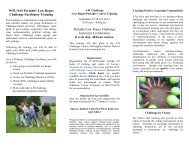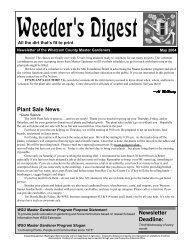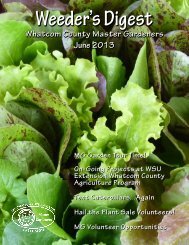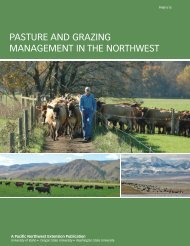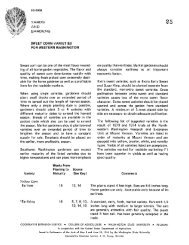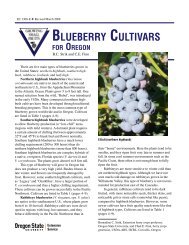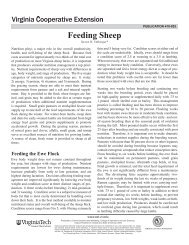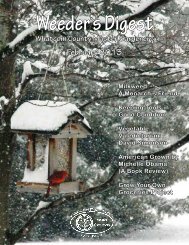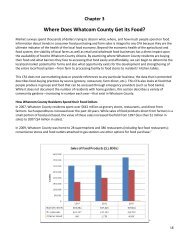August - WSU Whatcom County Extension - Washington State ...
August - WSU Whatcom County Extension - Washington State ...
August - WSU Whatcom County Extension - Washington State ...
Create successful ePaper yourself
Turn your PDF publications into a flip-book with our unique Google optimized e-Paper software.
All the dirt that’s fit to print<br />
Newsletter of the <strong>Whatcom</strong> <strong>County</strong> Master Gardeners<br />
<strong>August</strong> 2005<br />
Newsletter of the <strong>Whatcom</strong> <strong>County</strong> Master Gardeners<br />
Those of you who are volunteering for the Fair will receive a special mailing containing a letter detailing instructions,<br />
duties, parking and most importantly – your admission ticket. You will also get a copy of our entire Fair schedule, so you will<br />
know who you will be working with, and who will relieve you. If for some reason you must miss your scheduled time to work,<br />
you must pass your ticket on to the person who will take your place. We have to account for each ticket the Fair gives us, and<br />
we cannot get any more. If you have difficulty getting your replacement call Judy Boxx or Al to help you.<br />
Some of you are planning on entering exhibits at the Fair. We have some great tips for entering and winning ribbons with<br />
your vegetables and fruit on our web site, http://whatcom.wsu.edu/ag/agriculture.htm. so check it out and good luck.<br />
Remember, we still need volunteers at Hovander, and the office, during the Fair, so keep on volunteering for those activities<br />
as well.<br />
See you at the Fair!<br />
Al McHenry<br />
The Envelope Please!!!<br />
Wanted: Nominations for<br />
The Broken Shovel Award:<br />
This one’s easy. It’s for any Master Gardener who has put in oodles of volunteer hours and energy toward projects,<br />
committee work, office or clinics.<br />
The John VanMiert Master Gardener of the Year Award:<br />
This is a bit more involved. The recipient’s name will be added to the plaque in the office, and they will be presented with<br />
an individual award to keep at the Master Gardener graduation in November.<br />
The award is given annually to a person who has been a Master Gardener for at least three years. It is to be awarded for<br />
exemplary service to the Master Gardeners of <strong>Whatcom</strong> <strong>County</strong> and the community. John has had so much influence on us all as<br />
a teacher, a writer, a speaker, a diligent worker, and a volunteer extraordinaire. Therefore, the service of the recipient of this award<br />
might be in the form of one or more of the following:<br />
a. TAUGHT a class, a workshop, a clinic, a course, seniors at a retirement home, or kids on an outing.<br />
b. WRITTEN a book, a poem, an article, a newsletter column.<br />
c. SPOKEN to a group of children, a garden club, a class of Master Gardeners, the public.<br />
d. Spent far too many hours to count each year WORKING in support of a specific project, such as the Hovander demonstration<br />
garden, the annual plant sale, the greenhouse, cleaning and organizing the office.<br />
e. Given an extraordinary number of hours of VOLUNTEER TIME, such as keeping regular hours at the office no matter what,<br />
helping set up and run the Master Gardener classes, or putting in countless hours towards organizing the advanced<br />
training program.<br />
Please send in your nominations soon to Chris Hurst at cchurst@gte.net or 366-5501.<br />
<strong>WSU</strong> Master Gardener Program Purpose <strong>State</strong>ment:<br />
To provide public education in gardening and home horticulture based on research-based<br />
information from <strong>WSU</strong> <strong>Extension</strong>.<br />
<strong>WSU</strong> Master Gardener Program Slogan:<br />
”Cultivating Plants, People and Communities since 1973"<br />
Newsletter<br />
Deadline:<br />
Third Wednesday of every<br />
month.<br />
Cooperating agencies: <strong>Washington</strong> <strong>State</strong> University and U.S. Department of Agriculture. <strong>WSU</strong> <strong>Extension</strong> programs and employment are available to all without discrimination.<br />
Evidence of noncompliance may be reported through your local <strong>WSU</strong> <strong>Extension</strong> Office.
Weeder’s Digest<br />
Tis the Season<br />
By Faye Agner<br />
It seems as though summer is here.<br />
It got off to rather a stuttering start with<br />
unexpected rain in July. Now we can get<br />
on with our summer plans. If you are<br />
going to be gone, be sure and not leave<br />
signs of your being away by having<br />
newspapers, etc. pile up. Your neighbors<br />
will not thank you for this. Maybe you<br />
can bribe one of your friends/neighbors<br />
to take care of watering and such while<br />
you are gone. Tell them they can harvest<br />
from your garden as a reward.<br />
Now is the time to start planning<br />
for your winter and fall garden. Plant<br />
beets, cole crops (broccoli, cabbage,<br />
collards, kale, kohlrabi), leeks, lettuce,<br />
onions, peas, radishes, and spinach.<br />
<strong>August</strong> is the best time to prune<br />
fruit trees as it can help prevent rampant<br />
sprout growth next spring. Pruning at<br />
this time removes many of the leaves that<br />
transfer energy in fall to be used by the<br />
tree for growth in the spring. As long as<br />
you don’t remove more than a third of the<br />
foliage, the energy loss will not harm the<br />
tree. Prune to give the tree a vase shape<br />
rather than that of an umbrella. There is a<br />
hormone that makes growth happen at<br />
the highest point in the tree. If the center<br />
is the highest point, you get the Medusa<br />
effect with hundreds of sprouts growing<br />
right out of the middle. If the outer<br />
branches aim upward, the hormone<br />
causes growth where it is needed, at the<br />
tips of the branches, and sprout growth<br />
will be much less.<br />
As a general rule, fruit trees don’t<br />
need to be fertilized, instead, they need to<br />
be watered regularly in order to produce<br />
juicy, delicious fruit. As with most trees,<br />
the best way to water is with a soaker<br />
hose. The sun tends to degrade soaker<br />
hoses, so don’t forget to cover them with<br />
at least an inch of mulch. As an added<br />
benefit, the mulch will slow evaporation,<br />
cool the soil temperatures and make the<br />
water spread more evenly over the root<br />
zone.<br />
A trick to growing huge lilies next<br />
year is to feed them now, right after they<br />
quit blooming. Food manufactured in the<br />
leaves is sent down to be stored as<br />
energy in the bulb. The more energy<br />
stored, the bigger the bulb and the more<br />
spectacular your lily display will be next<br />
summer. Give your lilies a shot of organic<br />
bulb food now, and you will be rewarded<br />
with huge flowering stalks next summer.<br />
Powdery mildew is a common<br />
problem this time of year. Odd as it<br />
seems, the easiest way to prevent this<br />
fungus is to water adequately. Underwatered<br />
plants are highly susceptible.<br />
Powdery mildew is the only fungus that<br />
lives on the outside of the leaves. Unlike<br />
other fungus diseases, it can be easily<br />
controlled if a spray is applied at the first<br />
sign of the disease (it is too late once the<br />
leaves are covered).<br />
Bald-faced hornets are beneficial.<br />
These are the bees that make paper wasp<br />
nest in trees and shrubs like rhododendrons.<br />
They are large black (white spots<br />
on the head and rump) yellow jackets and<br />
eat lots of plant eating bugs. For fun,<br />
watch them hover just above the lawn<br />
looking for crane flies. The crane fly<br />
hides in the grass waiting for a chance to<br />
lay her eggs. If she is spotted by a baldfaced<br />
hornet as she is taking off, the<br />
hornet will swoop down and bite the<br />
crane fly’s head off in mid air. Next to be<br />
bitten off are the wings and the legs. The<br />
remainder of the crane fly is then taken<br />
back to the nest. Put up warning signs<br />
and barricades to make sure the kids and<br />
the dog don’t go near the nest.<br />
Tend your roses now. For a second<br />
flush of bloom in fall, give roses plenty of<br />
water during the warm <strong>August</strong> days and<br />
feed them with a complete fertilizer. Also,<br />
apply iron chelate if leaves look chloroic<br />
(yellow with green veins). Make certain<br />
the soil is moist before applying and<br />
water thoroughly afterward. Snip off old<br />
blooms and rose hips; lightly shape<br />
plants if necessary.<br />
Uneven watering causes cracked<br />
tomatoes. Cracked tomatoes are not only<br />
unappetizing; they are also quick to spoil.<br />
To avoid this problem, keep your<br />
tomatoes watered. If they are allowed to<br />
dry out and then are watered the plant<br />
takes up too much too quickly and the<br />
excess is stored in the fruit. The fruit<br />
cracks because as the skin turns red, it<br />
also looses flexibility and can’t expand to<br />
accommodate the excess fluid. To solve<br />
the problem, irrigate regularly and apply<br />
mulch to keep the soil evenly moist.<br />
Your plants will last better and take<br />
less watering by mulching around the<br />
roots to keep them cool. Mulch also<br />
helps water soak into the soil rather than<br />
run off and it slows evaporation. Mulching<br />
can take the form of organic material<br />
such as shredded leaves, which helps<br />
improve the soil as it conserves moisture.<br />
Let the size of your plant be your guide<br />
as to how deep to spread it. The larger<br />
the plant, the more mulch it can handle.<br />
You do not want to bury your low<br />
growing plants. If you do not have leaf<br />
mulch, shredded wood or bark works fine.<br />
It will not break down as fast to improve<br />
the soil. Be careful about using stone or<br />
gravel mulch. It can actually get very hot<br />
and cause moisture to evaporate rather<br />
than conserving it.<br />
If you don’t already have a<br />
compost pile, here is an easy way to start<br />
one. To hold the compost, join four 4-by<br />
4-foot square wood pallets, the kind used<br />
in home and garden stores, often<br />
available free if they are damaged, at the<br />
corners to make a bottomless, opentopped<br />
box. Toss in a blend of vegetable<br />
scraps (everything from apple cores to<br />
carrot tops) and garden waste such as<br />
grass clippings and seedless weeds.<br />
Water the pile to keep it as moist as a<br />
wrung-out sponge and turn it weekly<br />
with a garden fork. You’ll have rich<br />
compost in a couple of months. As you<br />
tear out spent summer flowers and<br />
vegetables, combine them with the grass<br />
clippings and non-meat kitchen waste to<br />
make compost for your fall garden.<br />
Who am I?<br />
I am from a genus of about 9<br />
species of bold, stiff perennials from dry<br />
prairies, gravelly hillsides, and open<br />
woodland in Central and Eastern North<br />
America. I usually have thick black<br />
rootstocks and short rhizomes. Erect,<br />
hairy stems bear linear-lance-shaped to<br />
ovate, entire, toothed or deeply pinnatifid,<br />
bristly, dark green leaves. Solitary,<br />
daisy-like, purple, red, pink or white<br />
flower-heads with pointed stiff scales on<br />
the undersides, and prominate, ovid or<br />
cone-shaped brownish yellow to orange<br />
central discs are produced on terminally,<br />
thick branched stems.
President’s Message<br />
Linda Bergquist,<br />
MGF President<br />
GREAT EXPECTATIONS<br />
Our <strong>Whatcom</strong> Master Gardener Foundation has a stated<br />
mission to help educate our community, and we have many<br />
activities aimed to do just that. In talking with members of other Master Gardener<br />
Foundations, and reading their newsletters, I find that we offer programs, trips, and<br />
events that they have never made available to their members. Our members often ask<br />
me, “When is our next trip?”, or “Who is speaking at the next Foundation meeting?”<br />
Most Foundations don’t even have monthly meetings!<br />
Thanks to Chris Hurst and Karen Gilliam we had a very informative trip in June.<br />
They did all the researching, calling, and organizing. We have come to expect these<br />
wonderful trips every year!<br />
Our Foundation meetings always have knowledgeable speakers and we have<br />
come to expect that too! Loretta Hogg and Gretchen White, as part of their VP duties,<br />
are responsible for a lot of research, organization, and scheduling to get these speakers.<br />
When we attend these meetings we have come to expect coffee, tea and wonderful<br />
goodies. Without Barbara DeFreytas and JoAnne Roose this would not be<br />
available.<br />
Our Advanced Training in the fall, one way each of us can fulfill our continuing<br />
education requirement, is attended by Master Gardeners from all over <strong>Washington</strong> and<br />
even some from Canada. Everyone expects the training to be fantastic! Loretta Hogg,<br />
Kaye Dykas, Chris Hurst, Ann Rogalla, Arlene Dangelmaier, Bill Baldwin, and Sandy<br />
Keathley have been working for a year on this event. I have seen the fruits of their<br />
labor and I know it will meet or exceed our expectations.<br />
Last year our NW <strong>Washington</strong> Fair Booth did us proud! From the looks of the<br />
plans for this year, Judy Boxx and Donna Berry will be working their magic again and<br />
we will have a very professional representation. We have come to expect this, too!<br />
Much of the community knows of our work at Hovander Park. Everyone expects<br />
it to be educational and beautifully presented. If David Simonson did not read many,<br />
many seed catalogs and start ALL the vegetables in his greenhouse there wouldn’t be<br />
a Demonstration Garden. If Dick Porter didn’t do the same for the Dahlia Garden it<br />
wouldn’t exist! Kendra Bradford and Christina Tawes have made the Native Plant<br />
Garden come alive! Barbara Schmit works on the perennials around the house and<br />
Elisabeth Bays is in charge of the Herb Gardens. Because of them our expectations are<br />
met.<br />
Pat Nelson, our volunteer coordinator, makes sure our community outreach<br />
mission is met. She gets requests from many different organizations in our area. They<br />
expect our usual hard work and dedication and we always deliver.<br />
Leslie Clark, one of our new members, sent in a request for help at Lydia Place.<br />
Christine Morris needs help at the Bellingham Farmer Market on Saturdays. These are<br />
great, new opportunities to show off our great organization, share our knowledge, and<br />
fulfill our education mission.<br />
SO, when YOU are called on to help, remember - we have great expectations for<br />
YOU, too! “I can’t help, I have already done my hours” just isn’t our style.<br />
Timesheets<br />
It’s July and many of you are working hard to fufill your volunteer hour commitment.<br />
Don’t forget to record those hours and submit them to the <strong>Extension</strong> Office on a<br />
regular basis.<br />
You can pick up a paper copy of the timesheet to fill out and mail in at the office.<br />
Or, why not submit your hours online: http://whatcom.wsu.edu/mastergardener/. Click<br />
on “For MG’s Only.” If you need the username and password to get into this secure<br />
area contact Karri Neuhauser at the <strong>Extension</strong> Office, 360/676-6736 or<br />
karrimac@wsu.edu.<br />
<strong>August</strong> 2005<br />
Annual Hovander<br />
Picnic!<br />
On<br />
Thursday,<br />
<strong>August</strong> 11, at<br />
6:30 p.m. we will<br />
have a pot luck<br />
dinner at the<br />
beautiful<br />
Hovander Park facility in Ferndale. For<br />
those of you who have never been, it is a<br />
real treat! Please bring your family! After<br />
dinner you can show them, the new<br />
Economic Garden, the progress at the<br />
Demonstration Garden, the Native Plants<br />
Garden and the Historical house and<br />
surrounding gardens. They are all a short<br />
stroll from the picnic area. You will see<br />
the Group Picnic sign just as you are<br />
about to turn toward the parking area.<br />
You drive straight ahead and follow the<br />
gravel road until you come to a covered<br />
picnic area, with a cement floor, fireplace,<br />
and picnic tables. They hold weddings<br />
and special events in this facility. BRING<br />
YOUR FAMILY’S FAVORITE DISH!<br />
Bring an entrée, salad or dessert. You<br />
may bring your own place settings or we<br />
will provide them. We will have water,<br />
juice, coffee and tea. It has always been<br />
lots of fun!<br />
Advanced Training<br />
Seminar,<br />
Friday, September 30 -<br />
Hampton Inn<br />
EARN 5<br />
HOURS OF<br />
ADVANCED<br />
TRAINING<br />
CREDIT IN ONE<br />
DAY!<br />
Look for<br />
your seminar<br />
brochure enclosed in this issue of the<br />
Weeders Digest. Please return your<br />
registration ASAP. You will enjoy hearing<br />
from the four speakers: Sharon Collman,<br />
Sam Benowitz, Mary Robson and Russell<br />
Link; reviewing numerous display<br />
materials and books by the authors, and<br />
sharing gardening news with fellow<br />
Master Gardeners over lunch.
Weeder’s Digest<br />
Plant of the Month............................ By Cheryll Greenwood Kinsley<br />
Kale<br />
Family: Cruciferae<br />
(Mustard family)<br />
Genus: Brassica<br />
Species: oleracea<br />
Texas A&M University Department of<br />
Horticultural Sciences and Aggie Horticulture<br />
This month’s article is as much a reminder for me as anything else, to start some kale from seed in<br />
flats about now. I love the look of our gardens this time of year—exuberant, more than slightly overgrown,<br />
and very colorful. In the vegetable plot as well as the flowerbeds, everything tumbles together:<br />
blossoms, fruit, and seedheads, twining vines and leafed-out branches. As the summer progresses,<br />
however, it will be time to start taking things out, whether nasturtiums or petunias, and there will be<br />
holes here and there. While I won’t be able to recapture summer’s exuberance as<br />
we move into fall, I can be prepared with some fresh stock to cover patches of bare<br />
earth.<br />
For years I dismissed ornamental kale as too garish. There was something<br />
almost artificial about that combination of pink, purple, and teal that didn’t sit right<br />
with me. But tastes change. New varieties become available. And a couple of years<br />
ago I found myself coveting some “flowering” kale with either pure red or clear<br />
white centers clustered within outer leaves of true, deep green. The only trouble?<br />
They were pretty pricey, particularly if I wanted a number of them to line a walkway<br />
or fill several containers.<br />
But for half the price of a single plant at the nursery, I can buy one packet of<br />
seeds. The trick is to start them at the right time, in the right way, so I’ll have as<br />
many pretty heads of ornamental kale as I need.<br />
Now is the time—don’t wait past early <strong>August</strong>—and flats are the way to go.<br />
I sow leafy kale—the kind I plan to eat—directly into the ground, in the place set<br />
aside for vegetables. Unlike chard, it doesn’t suit me to mix it in with my ornamentals.<br />
I like to harvest the thinnings and then keep taking the outer leaves while<br />
they’re small to use in September salads. As the weather cools, the plants grow bigger and their leaves<br />
become both tougher and sweeter, making them perfect for pot greens by November. So the kale I plant<br />
to eat really needs a place of its own.<br />
But the kale I plan to admire is treated a little differently. By sowing seeds in flats now, I’ll have starts to transplant into small<br />
pots in a month. And by the first of October, if I tend them properly, I’ll have a number of pretty little heads of ornamental kale to<br />
put along the walkway or in containers by the front door. I might choose ‘Sunset’ or ‘Sunrise’—can you guess how these differ in<br />
color?—or the particularly attractive Nagoya mix for pure white and pure red. The plant breeders have been busy with kale during<br />
the last two decades, taking the most ancient of the Cruciferae to new aesthetic heights for our modern sensibilities. What we call<br />
kale is the forerunner of broccoli, Brussels sprouts, and most cabbages. The Greeks ate it, the Romans followed suit and took it on<br />
the road with them all over Europe.<br />
The trick to growing kale is to make sure it has cool weather as it matures. But it also needs warmth to germinate. So for our<br />
region, it’s the perfect fall crop—particularly the ornamental varieties. Starting seeds in flats, outdoors, now avoids many of the<br />
problems associated with starting seeds indoors in late winter and early spring. Better air circulation, and fresh air in general, means<br />
less chance of damping-off. The starts are likely to be sturdy and healthy. By transplanting them into small pots and keeping them<br />
well-watered and lightly fed, you’ll be able to choose the best-looking heads as ornamental features. And if you use a seed mix,<br />
you’ll have a clear fix on the colors you’re dealing with so you can place them where the combinations will please you. One other<br />
advantage: not all of them will look like the ones in the catalog. Some will be irregularly shaped, some will look lumpy. You’ll be able<br />
to select the best of the lot. Plant them in the ground up to their first set of leaves, and you’ll keep them from growing lanky and<br />
flopping over. The cool fall weather will bring out their color, once they’re safely tucked in the ground.<br />
And yes, you can eat any ornamental kale that doesn’t make the cut. It’s not as tasty or tender as the culinary varieties—it’s<br />
bred for looks, remember—but it’s still nutritious and pleasant to eat when you toss a handful of leaves cut into strips into soup, for<br />
example, during the last few minutes of cooking time.<br />
So, if you start some ornamental kale right away, no later than mid-<strong>August</strong>, you’ll have the opportunity this year to have your<br />
kale and eat it, too.<br />
Hovander Update<br />
Projects at the demonstration garden are looking well tended as late summer nears. We’ve had lots of volunteers lately to<br />
zero in on the weeds in the pumpkins and corn maze.<br />
We’ve experienced the usual problems such as lots of cabbage worms and slugs. And, the long-standing ritual of sampling<br />
fava beans will not happen this year as our plants couldn’t survive a peacock attack!<br />
We’re hoping to have a big turnout at the <strong>August</strong> MG picnic here at Hovander Park. While here—be sure to check out the<br />
various projects that volunteers have worked so hard on this year.
<strong>August</strong> 2005<br />
Youth and Gardening<br />
~Craig MacConnell<br />
The latest issue of HortTechnology (July – September<br />
2005, V. 15, n 3) contains a special section on Youth in Horticulture<br />
with eleven scientific papers presented on the topic. Three<br />
of the papers give results from the utilization of the Junior<br />
Master Gardener program originally developed by Texas A& M<br />
University and now a national 4-H program that is replicated in<br />
twenty eight Land Grant universities.<br />
The Junior Master Gardener program engages children in<br />
novel, “hands-on” group and individual learning experiences<br />
that promote a love of gardening, develop an appreciation for<br />
the environment, and cultivate the mind. JMG encourages youths to be of service to others through<br />
service learning and leadership development projects and rewards them with certification.<br />
The Junior Master Gardener curricula are divided into two age/grade ranges. JMG Level One is<br />
developed for grades 3 - 5, where children taking part can get involved in exploring their world<br />
through meaningful activities that strengthen academic achievement, encourage leadership development,<br />
personal pride and responsibility, and community involvement. Youths involved in the program develop critical thinking<br />
skills, and the ability to identify community concerns and take action to address them through individual group projects. JMG<br />
Level Two is designed for grades 6 – 8 and includes the “Operation Thistle – Seeds of Despair” module where middle school and<br />
junior-high youths investigate Plant Growth & Development while engaging them in an urgent mission to defeat the evil Dr. Thistle.<br />
Students will work as a group to complete lessons in each of the 8 learning concepts, then work independently to complete activities<br />
found within the mission briefs & mission option pages. By completing these missions, students help foil the twisted plans of<br />
Thistle and his menacing gang while reinforcing concepts learned in the group setting. Shades of Harry Potter.<br />
In addition to the grade based curricula, the Junior Master Gardener program has also developed stand alone, theme based<br />
curricula, called the Golden Ray Series, such as Health and Nutrition from the Garden and Wildlife Gardener in conjunction with the<br />
National Wildlife Federation.<br />
Leanna Smith and Carl Motsenbocker, with Louisiana <strong>State</strong> University report in their study of three East Baton Rouge Parish<br />
elementary schools using the first four chapters of JMG Level One Handbook that changes in pre and post science achievement<br />
scores were statistically better for the group that participated in the JMG curricula as compared to a control group. The authors<br />
state “…the results show once weekly use of gardening activities and hands-on classroom activities help improve science achievement<br />
test scores.”<br />
Amy Dirks and Kathryn Orvis, with Purdue University, Indiana, report in their study of eleven schools in ten counties in<br />
Indiana that student pre and post tests indicated overall significant gains in science, horticulture, and environmental knowledge<br />
and attitudes as a result of receiving training using the Junior Master Gardener curriculum. According to Dirks and Orvis, teachers<br />
indicated that they were satisfied with the program in their classrooms and planned to continue with the JMG for future classes.<br />
Poston, Shoemaker, and Dzewaltowski, all with Kansas <strong>State</strong> University, report student changes as a result of two after school<br />
programs with the Boys and Girls Club, Professor Popcorn, a nutrition education program developed<br />
by Purdue, and the Junior Master Gardener program. The authors found that neither program improved<br />
nutrition knowledge nor fruit and vegetable preferences or consumption. The authors did<br />
indicate that there was potential for bias in selection of the student participants.<br />
A team of members of the 2005 <strong>Whatcom</strong> <strong>County</strong> Master Gardener class did pilot the Junior<br />
Master Gardener program material this year. Soon we will have our own qualitative data on JMG<br />
program and its impact on <strong>Whatcom</strong> <strong>County</strong> youth.<br />
For more information on the Junior Master Gardener program see http://www.jmgkids.us/ or<br />
Google for a large number of state JMG websites.<br />
Office:<br />
Master Gardener<br />
1000 N. Forest St., Suite 201<br />
Bellingham, WA 98225<br />
360/676-6736<br />
Weeder’s Digest is the monthly newsletter for the <strong>Whatcom</strong> <strong>County</strong> Master Gardener Program. Guest articles are encouraged. Please submit<br />
typewritten articles by the third Wednesday of each month to Karri at the Master Gardener Office. Articles can also be submitted by e-mail to:<br />
karrimac@coopext.cahe.wsu.edu. Editor uses MS Word for Windows and PageMaker 6.5. Any articles prepared on other programs or platforms<br />
should be saved as Text Files or Rich Text Files. Editor reserves the right to edit for space considerations, grammar, spelling and syntax.<br />
Craig MacConnell<br />
Horticulture Agent
<strong>WSU</strong> WHATCOM COUNTY EXTENSION<br />
1000 N. FOREST STREET, SUITE 201<br />
BELLINGHAM WA 98225-5594<br />
PRSRT STD<br />
US POSTAGE<br />
PAID<br />
BELLINGHAM WA<br />
PERMIT NO. 85<br />
Dates to Remember:<br />
<strong>August</strong> 4........................... 10 a.m. to noon ....................Monthly Foundation Board Meeting<br />
<strong>Extension</strong> Office<br />
<strong>August</strong> 11 ......................... 6:30 p.m. ..............................Monthly Foundation Meeting<br />
Annual Potluck at Hovander<br />
<strong>August</strong> 15 -20 .................. All Day .................................Northwest <strong>Washington</strong> Fair<br />
Lynden<br />
September 7 -9 ................ All Day .................................WA <strong>State</strong> Annual MG Conference<br />
Pullman, WA<br />
September 30 .................. All Day .................................<strong>Whatcom</strong> <strong>County</strong> MG Advanced Training<br />
Fox Hall, Hampton Inn<br />
Wednesdays .................... 8 to 9 a.m. ............................Master Gardener breakfasts<br />
Babe’s in Ferndale<br />
Wed. & Sat. ..................... 9 a.m. to noon ......................Hovander Work Parties<br />
Wednesday...................... 1 to 4 p.m. ............................Bellingham Library Clinic<br />
Saturdays......................... 9 a.m. - 2 p.m. ......................Bellingham Farmers Market Booth



